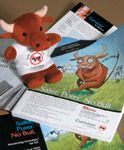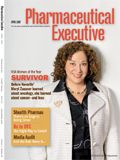Marketing to Professionals: Everyone's a Comedian
Pharmaceutical Executive
Have the confidence to step outside the norm. A targeted, humorous campaign will attract attention more quickly.
We all enjoy a good laugh. So why is humor so obviously missing in the pharma marketing regimen? We all respond to a gecko selling car insurance, a duck selling life insurance, and unemployed sheep loitering outside the bedroom window. We laugh, we remember, and we buy the products. Why do we feel we must leave our levity at the door when we reach our office?

Joleen Schultz
The answer is that the idea of using humor may make us uneasy. The judicious use of humor can reinforce the key message, be in alignment with the brand image, and be relevant to the objective. However, it requires a deep understanding of a product's core benefit to the physician, a concise value proposition, and the confidence for pharma companies to step outside the advertising norm.
Branding in the pharma industry historically has been on the conservative side. Companies have relied on scientific data and clinical progress as a backdrop for branding. However, pharmaceutical companies today face a series of significant challenges, including increasing competition against generic products and a dwindling pipeline, which require thinking and acting differently to maximize a drug's potential and relevance beyond patent expiry. Humor may be the right form of creativity to cause audiences to connect with and develop a loyalty for your brand.

Halozyme Therapeutics dabbled in barnyard humor with its Cumulase ad campaign, which caught the attention of fertility doctors.
This article is intended to open your mind to the possibility of using humor in branding and to provide some guidelines to get you started.
What is Funny?
Physicians are bombarded with sales reps, sales slicks, sales premiums, and more data than a college statistics class. Marketers must look for new ways to grab physicians' attention. We all know that people respond to emotion. Unfortunately, we forget that humor can evoke especially strong emotions that strike both personal and universal chords. Incorporating humor into branding can create a positive perception of approachability, honesty, and realness.
However, it's not as easy as it looks.
You must be careful to not lose the message in your quest for a humorous campaign. Consider humor the vehicle to deliver the message, not the message itself. We can all name commercials that are funny, but we can't always recall the names of the products. The closer the punch line aligns with your value proposition, the more effective the branding effort.
In addition to entertaining us, humor in branding must evoke a response. Therefore, the humor must relate directly to your product if you want to be remembered.
Road Map to a Laugh
Following are some guidelines for incorporating humor into a branding campaign.
- Explore the humanistic side of the product benefits. Is there a setting or routine that individuals will readily relate to?
- Be sensitive to the seriousness of the condition your product addresses. Humor works extremely well with lifestyle drugs, such as those that treat depression and sleeplessness.
- Carefully consider the cultural sensitivities of a global audience in your marketing efforts—humor might not always translate. Yet there are many concepts that have universality: puppies, babies, and talking animals.
In all instances, the comedic payoff must have a strong tie to the product benefit. If the professional audience cannot immediately make the connection to the primary product benefit, the campaign is not going to be effective.
The use of humor or the degree of emphasis must be evaluated in relation to the communication vehicle. Humor can be especially effective in direct-mail efforts, where strong visual elements and impactful type can draw recipients' attention and save the mailer from hitting the wastebasket. On the other hand, the character should have a supporting role in more scientifically-oriented sales pieces.
Humorous campaigns have a relatively short life. Marketers must continually refresh their approach to keep the audience's interest. This can be through a change in setting, new characters, different situations, etc.
Test your concept before launching it. Brainstorm within your core marketing group. Ask trusted physicians for their opinion. Test it in focus groups. If the audience doesn't see the humor or get the message, then the joke is on you.
Avoid certain topics in the branding of a pharma product. Don't rely on politics, religion, race, or anything risqué to garner attention. If you have to explain or apologize for the joke, the campaign is a failure.
Most importantly, have the confidence to step outside the norm. A targeted, humorous campaign will attract attention more quickly. This can be especially beneficial for a smaller pharmaceutical company or a company with a modest budget.
Barnyard Humor
Halozyme Therapeutics needed to grab attention and convey its product's key benefits—fast. So it took a gamble with a little barnyard humor when it launched Cumulase into the US and European infertility markets. Cumulase, a recombinant human enzyme, can replace bovine and ovine animal-derived hyaluronidases used to prepare eggs for certain IVF (in vitro fertilization) procedures. Cumulase provides a safer, purer, and more reliable alternative to bovine and ovine slaughterhouse-derived extracts. So the company chose the tagline "Safer. Purer. No Bull"—a short, catchy phrase that served as an inside joke with fertility doctors, who understood the correlation between the catch phrase and the product.
Halozyme didn't stop there. An expressive cartoon bull was developed as the product mascot. The bull image was incorporated into direct mail, print advertising, booth graphics, and a poster (at the request of lab directors) for physicians' offices—there was even a stuffed bull adorned with a Cumulase T-shirt as a tchotchke at conferences. This memorable bull enabled the company to quickly build brand recognition and communicate the key benefit of its product. However, the company did not rely solely on humor to deliver the message. In all instances, the clever tagline and memorable image was backed by clinical data.
Dual Functionality
As more attention is paid to DTC branding, marketers are looking for ways to build a single, compelling brand among physicians and patients. This two-for-one branding effort reduces creative development costs and leads to a stronger, more cohesive brand image.
Consider the Mucinex brand. The Mucus family is a classic example of building a consistent brand image among physicians, pharmacists, and patients. Mucinex products are designed to break up the mucus causing congestion so that patients can cough it up more easily. To hammer the point home, the company created the tagline "Mucinex in. Mucus Out."
In the field, the sales reps build brand awareness and drive product adoption by delivering an in-office detail binder featuring the Mucus family members and their corresponding products. The lighthearted campaign is supported by study data and claims.
The crossover into the patient audience begins with representatives providing physicians with in-office discount coupons featuring the not-so-friendly Mucus character and the descriptive tagline. Shelf talkers featuring the Mucus family and providing product information on the Mucinex family of products are left in the physician's lobby.
Branding is promoted even further by providing product information with a special mail-in rebate at the point of purchase in the pharmacy. This campaign was well received by physicians and pharmacists who believe that the endearing Mucus family members have aided in patient acceptance of the product and even enhanced patient compliance.
The branding campaign is also flexible enough to address product extensions, including Mucinex DM, Mucinex D, and Children's Mucinex, where the characters' ages and situations are modified to more closely align with the product.
Punch Line
The trend for using humor in pharmaceutical branding is beginning. Will humor work in your pharmaceutical branding efforts? Absolutely—if it can make an emotional connection with your audience and if it reinforces your key product benefit. We know humor can definitely get attention. So lighten up and have some fun with your next campaign.
Joleen Schultz is principal and national practice leader, life science at Mentus. She can be reached at jschultz@mentus.com

The Misinformation Maze: Navigating Public Health in the Digital Age
March 11th 2025Jennifer Butler, chief commercial officer of Pleio, discusses misinformation's threat to public health, where patients are turning for trustworthy health information, the industry's pivot to peer-to-patient strategies to educate patients, and more.
Navigating Distrust: Pharma in the Age of Social Media
February 18th 2025Ian Baer, Founder and CEO of Sooth, discusses how the growing distrust in social media will impact industry marketing strategies and the relationships between pharmaceutical companies and the patients they aim to serve. He also explains dark social, how to combat misinformation, closing the trust gap, and more.